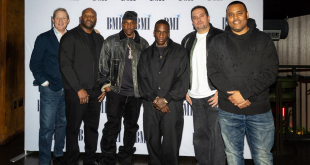For the first time in two years, the Country Music Association gathered at the renowned Hall of Fame Rotunda at the Country Music Hall of Fame® and Museum to reveal the 2022 inductees into the Country Music Hall of Fame – Joe Galante, Jerry Lee Lewis and Keith Whitley.
Galante will be inducted in the “Non-Performer” category, which is awarded every third year in rotation with “Recording and/or Touring Musician” and “Songwriter” categories. Lewis will be inducted in the “Veterans Era Artist” category and Whitley will be inducted in the “Modern Era Artist” category.
Country Music Hall of Fame members and Country duo Brooks & Dunn hosted the press conference to announce the news via livestream on CMA’s YouTube channel.
“This year’s inductees are trailblazers who each paved their own unique path within Country Music,” says Sarah Trahern, CMA Chief Executive Officer. “Jerry Lee, Keith and Joe each found their musical callings early in life and displayed a strong-minded and fierce passion for music making. In very different ways, they all have left a lasting impact on the industry and generations of fans alike. I am thrilled to welcome this deserving class into the Country Music Hall of Fame.”
“When I heard the news I was being inducted into the Country Music Hall of Fame, it was the first time in my entire career I was speechless,” says Galante. “I’m humbled, beyond honored and honestly, I’m still trying to wrap my head around this.”
“To be recognized by Country Music with their highest honor is a humbling experience,” says Lewis. “The little boy from Ferriday, LA listening to Jimmie Rodgers and Hank Williams never thought he’d be in a Hall amongst them. I am appreciative of all those who have recognized that Jerry Lee Lewis music is Country Music and to our almighty God for his never-ending redeeming grace.”
“In my heart, this feels like an absolutely appropriate honor, but at the same time, I know that Keith would be painfully humbled, and even shy about accepting an induction into the Country Music Hall of Fame,” says Grand Ole Opry star, Lorrie Morgan, who was married to Whitley until his untimely passing. “Music was all about emotion to Keith. It was personal. There were so many great artists he admired, even worshipped. To stand in their company in the Hall of Fame would’ve been overwhelmingly emotional for him. I am thrilled to see him honored this way, and for what it means to my children, Morgan and Jesse Keith; to Keith’s grandchildren; the Whitley family; and to the many, many fans who continue to point to Keith as one of the all-time greats.”
“Our new inductees come from three very different places, but in October they will be enshrined in the very same place,” says Kyle Young, Country Music Hall of Fame and Museum Chief Executive Officer. “Jerry Lee Lewis is a God-fearing rabble-rouser from a Mississippi River town, way down South. Keith Whitley was a Lefty Frizzell-loving Country boy from rural Kentucky. And Joe Galante is a game-changing executive from the urban northeast. They all filled our worlds with music. They are all deserving of our respect and adulation, and their elections into the Country Music Hall of Fame ensure that respect and adulation will endure through the ages.”
A formal induction ceremony for Galante, Lewis and Whitley will take place at the Country Music Hall of Fame and Museum in the CMA Theater this fall. Since 2007, the Museum’s Medallion Ceremony, a reunion of the Hall of Fame membership, has served as the official rite of induction for new members.
Media assets are available for download at CMApress.com.
Non-Performer Category – Joe Galante
When then RCA Records transferred Joe Galante from New York to its Nashville office in 1974, he never imagined he’d still be in Music City 49 years later. Nashville certainly had no clue how the 24-year-old “New Yorker” would transform the Country Music industry, becoming the longest-tenured major-label head in its history. During his 39 years with what is now known as Sony Music Nashville, Galante displayed marketing acumen, strategic sense and tenacious competitiveness that motivated other labels and raised the bar for the industry at large.
Galante grew up in Queens, NY as the oldest of three children in a typical Italian family household. He attended catholic schools for his primary education and graduated from Fordham University in the Bronx with a finance and marketing degree.
Galante joined RCA Records in New York as a budget analyst in 1971, shortly after graduating from Fordham. The move to Nashville came at a time when the label wanted to develop more decision-making autonomy within its Country division. Galante, who had moved into product management by the time, had little familiarity with Country Music outside the occasional crossover hit he’d heard on New York radio, but he learned the music and the business from RCA giants Jerry Bradley and Chet Atkins.
Galante entered a closed system that often viewed outsiders with suspicion, yet what he had initially envisioned as a two-year assignment turned into a life’s path. In less than a decade, Galante succeeded Bradley as the head of RCA’s Nashville office, that promotion coming after he had led and re-imagined the division’s promotion and marketing departments. It’s no coincidence that RCA Nashville’s first Platinum album — 1976’s Wanted! The Outlaws compilation — came after Galante’s arrival. He also helped steer RCA’s late-1970s and early 1980s crossover successes with such artists as Waylon Jennings, Ronnie Milsap, Sylvia and Dolly Parton.
Galante was 32 when he took the helm at RCA Nashville, the youngest person to ever lead a major label’s Nashville division. Under his leadership, RCA became Country’s top label in 1982 and held that spot for 11 years.
He shepherded the multi-Platinum ascendance of Alabama using a pop marketing model. He signed a wide roster of talent including Clint Black, Kenny Chesney, Sara Evans, Vince Gill, The Judds, Martina McBride, Lorrie Morgan, K.T. Oslin, Carrie Underwood, Keith Whitley, Chris Young and others.
In 1990, Galante married Phran Schwartz in Nashville before the couple returned to New York where he was named President of RCA Record Label – U.S., becoming the first Music Row label chief to run a major label’s entire U.S. operation. His signings while there included the Dave Matthews Band, SWV and Wu-Tang Clan.
He came back to Nashville in 1994 as chairman of RCA, which had been purchased by Bertelsmann and operated under the name BMG/Nashville, including both the RCA and BNA Records labels. In 2000, Arista Nashville came under the BMG/Nashville umbrella with a roster that included Brooks & Dunn, Alan Jackson and Brad Paisley. In 2004, BMG/Nashville became the first label group of the SoundScan era to place three Country albums — Jimmy Buffett’s License to Chill (RCA/Mailboat), Kenny Chesney’s When the Sun Goes Down (BNA Records) and Alan Jackson’s What I Do (Arista Nashville) atop the Billboard 200 chart in a calendar year.
In 2006, Galante oversaw the evolution of BMG/Nashville into Sony BMG Nashville, with the addition of the former Sony Nashville and its Columbia Nashville imprint, with artists like Miranda Lambert, Gretchen Wilson and Montgomery Gentry. Sony BMG Nashville became Sony Music Nashville in 2009. Galante exited Sony Music Nashville as chairman in 2010.
While his record label prowess remains a highlight of his legacy, his dedication to mentoring younger generations of music professionals is perhaps one of his most admired and impactful contributions. Since leaving Sony Music Nashville, Galante has served as a mentor-in-residence for Nashville Entrepreneur Center, where he founded Project Music. He is also a founding member of Leadership Music, now in its 33rd year.
Galante has been a member of the Country Music Association Board of Directors since 1978 and the CMA Foundation Board of Directors since 2011, serving as chairman of both organizations. In 2021, CMA honored him with the J. William Denny Award, to honor a lifetime of dedication, distinguished service and meritorious contributions to the CMA Board of Directors. Additionally, he received the Bob Kingsley Living Legend Award from the Opry Trust Fund in 2015, becoming the second person, after national radio host Kingsley, to be so honored.
Galante has served as a consultant to BMG Music and Morris Higham Management, and he has chaired the Music City Music Council, a group of leaders dedicated to further establishing Nashville’s position as the global music capital.
He currently serves on the boards of Pinnacle Financial Partners and Cumberland Pharmaceuticals. He also serves on the board of Fishbowl Spirits, LLC, and on the Music Advisory Council for Abe’s Garden, an Alzheimer’s care and learning center. He established the Phran Galante Memorial Fund for Lung Cancer Research at the Vanderbilt-Ingram Cancer Center, in the wake of Phran’s passing in September 2019.
Galante has raised the bar for executives in the Country Music industry — whether they were working for him, in concert with him or competing against him. He becomes the third chief of Sony Music Nashville to join the Country Music Hall of Fame, following Atkins (1973) and Bradley (2019).
As Trahern says, “Nashville would not be Nashville without Joe Galante.”
Veterans Era Artist Category – Jerry Lee Lewis
When 21-year-old Jerry Lee Lewis arrived at Memphis, TN’s Sun Records, he was introduced to owner Sam Phillips as a man who could play the piano the way Chet Atkins played guitar. That description may have piqued Phillips’ curiosity, but, truth was, Lewis didn’t sound a thing like Atkins, and he played the piano like nothing anybody had ever heard before.
Lewis’ ferocious, key-pounding style derived from a combustible mix of cultural sources — the Assembly of God holiness church of Ferriday, LA; Haney’s Big House, a chitlin’ circuit nightclub on the other side of town where Lewis witnessed a young B.B. King and all manner of other blues and R&B acts; the Jimmie Rodgers records embedded deep within his formative memories; the Al Jolson 78s played before Gene Autry matinees at the local movie house; and Hank Williams’ mournful wail carried across the air via “The Louisiana Hayride.” Those things all came together in Lewis and came out through his fingers with the speed of lightning and the force of thunder.
He is, as music historian Colin Escott has noted, “a rock ‘n’ roller who could never quite get the Country out of his soul, and a Country singer who could never forget rock ‘n’ roll.”
The first record Sun released on Lewis was a cover of Ray Price’s “Crazy Arms,” cut while the original was still on the charts. The first hit, though, came with a song originally recorded by R&B singer Big Maybelle but that Lewis had learned via a Natchez, MS, DJ named Johnny Littlejohn. “Whole Lot of Shakin’ Going On” simultaneously spent two weeks in 1957 atop Billboard’s Country and R&B best-sellers charts, peaking at No. 3 on the Top 100. The following year saw follow-up “Great Balls of Fire” top the Country chart for another two weeks.
Controversy derailed Lewis’ early success, but not before Lewis hit the Country Top 10 three more times with “You Win Again,” “Breathless” and “High School Confidential,” each of which peaked higher on the Country charts than they did on the pop side.
In the 1960s, Lewis left Sun for Smash Records. Where Sun had emphasized Lewis’ abilities as a boogie-woogie rock-and-roll piano man, Smash producers Jerry Kennedy and Eddie Kilroy decided to focus on his Country side. They returned him to the radio with songs like “Another Place Another Time” and “What’s Made Milwaukee Famous (Has Made a Loser Out of Me).” That may have seemed like a radical idea given Lewis’ wild-man reputation, but it also fit the moment. Within months of Lewis having his first chart-topping Country hit in 11 years — “To Make Love Sweeter for You” in 1969 — Johnny Cash, Sonny James and Conway Twitty, all singers who’d hit it big during the dawn of rock and roll, topped the Country charts, as well.
The Country hits continued into the 1970s as Lewis moved to Smash’s parent label, Mercury Records, and later the Nashville division Elektra Records. He reached No. 1 with “There Must Be More to Love Than This,” “Would You Take Another Chance on Me” and a cover of the Big Bopper’s 1950s rock and roll classic, “Chantilly Lace.” He hit the Top 5 with a pair of signature ballads, the 1977 waltz “Middle Aged Crazy” and the 1981 honky-tonker “Thirty Nine and Holding.”
In all, he placed 28 Top 10 Billboard Country singles across four decades, a greater number of hits over a longer period of time than what appeared on the pop charts, where only a half-dozen sides made the Top 40.
Lewis has continued to record as his acolytes take him into the studio and as subsequent generations discover his music, even recording a 2011 live album at Jack White’s Third Man Records. His name has appeared in Country hits by George Jones (“Who’s Gonna Fill Their Shoes”), John Michael Montgomery (“I Love the Way You Love Me”), Tim McGraw (“Southern Voice”) and the Statler Brothers (“How to Be a Country Star”) — though, of course, nobody drops his name more in their songs than he does himself.
“Whole Lot of Shakin’ Going On” is now part of the National Recording Registry. That and “Great Balls of Fire” are in the Grammy Hall of Fame. While those two records are, by far, his most famous, those who know his catalog more deeply understand that he has full mastery of a century’s worth of popular music, from 19th-century minstrel tunes to the songs of Tin Pan Alley standards to classic rock.
Lewis joins Sun Records compatriots Cash, “Cowboy” Jack Clement, Phillips and Elvis Presley in the Country Music Hall of Fame. He is also the fourth member of the Rock and Roll Hall of Fame’s founding 1986 class of inductees to also gain membership in the Country Music Hall of Fame, along with Presley (1998), the Everly Brothers (2001) and Ray Charles (2021).
While Lewis now joins a select group, he also remains uniquely individual in that company. “My style of Country Music is just me,” Lewis told the Associated Press in 2017. “I wouldn’t know how to do anyone else’s.”
Modern Era Artist Category – Keith Whitley
Most Country Music Hall of Fame careers are marked by their longevity. It’s not a requirement, though. Lefty Frizzell, Jim Reeves, and the Louvin Brothers’ Ira Louvin all died in their 40s. Patsy Cline was just 30 at the time of her passing. The first two performers inducted into the Hall of Fame — Jimmie Rodgers and Hank Williams —were gone by 35.
Four years seven months and 10 days passed between Keith Whitley’s first appearance on the Billboard Country singles charts and his death on May 9, 1989, at 34. It’s the briefest chart span of any Hall of Famer during their lifetime, nearly six months shorter than Williams’.
From another perspective, Whitley had a 30-year career, one that began when he was 4 years old, dressed in a black cowboy outfit and singing Marty Robbins’ “Big Iron” and George Jones’ “A Wandering Soul” for talent shows around his hometown of Sandy Hook, KY.
Whitley made his radio debut at age 8, appearing on singer Buddy Starcher’s show on WCHS-AM in Charleston, WV. In his teens, he formed a bluegrass band, the East Kentucky Mountain Boys, with his brother Dwight, performing on WGOH-AM in Grayson, KY, and once a month on a UFH television show out of Hazard, KY. During that time, he met future Hall of Famer Ricky Skaggs, and the two teens bonded over their shared love of the Stanley Brothers. Whitley and Skaggs soon began performing the Stanleys’ songs together, and within months, Ralph Stanley hired them as members of his Clinch Mountain Boys.
Whitley recorded several albums with Stanley, as well as two early 1970s albums with Skaggs — Tribute to the Stanley Brothers (Jalyn Records) and 2nd Generation Bluegrass (Rebel Records). After leaving Stanley’s band, he joined J.D. Crowe and the New South from 1978 to 1982.
Whitley had been coming to Nashville since his teens, having been told by Mac Wiseman that his real future was in Country Music, and he moved there after leaving Crowe’s band. He met Lorrie Morgan in a studio at Acuff-Rose Music, where Morgan worked as a receptionist and Whitley was cutting the demo of “Does Fort Worth Ever Cross Your Mind,” which would become a chart-topper for George Strait. Whitley and Morgan married in November 1986.
By that time, Whitley had been signed to RCA Records by then-Vice President of Nashville Operations Joe Galante. Whitley’s debut EP, 1984’s A Hard Act to Follow, achieved little success, its two singles peaking outside Country’s Top 40. A full-length album, L.A. to Miami, fared better the following year, putting “Miami, My Amy” into the Top 20 followed by three Top 10 singles — “Ten Feet Away,” “Homecoming ’63,” and “Hard Livin’.”
Whitley found his artistic and commercial breakthrough with the next album, 1988’s Don’t Close Your Eyes. Three tracks produced with Garth Fundis – the title track, “When You Say Nothing at All” and “I’m No Stranger to the Rain” — found a perfect blending of bluegrass and honky-tonk traditions into contemporary Country, giving Whitley his first No. 1s. They still resonate more than 30 years later, a trio of singles with few parallels in terms of impact.
For a new version of Lefty Frizzell’s “I Never Go Around Mirrors,” Whitley convinced writer Whitey Shafer to craft an additional verse. On the day Whitley recorded the song, he visited Forest Lawn Memorial Gardens near his house in Goodlettsville, TN, and read the new lyrics over Frizzell’s grave.
One month after “I’m No Stranger to the Rain” hit the top of the charts, Whitley passed away in his home.
Unlike so many of his fellow Country Music Hall of Fame members, he never performed at the CMA Awards. He never became a member of the Grand Ole Opry. (Unknown to him, his invitation had been set for three weeks after his death.) His first Gold-record certification, for Don’t Close Your Eyes, came two months after his death, and his Grammy Awards nominations and CMA Awards came posthumously. A completed third album, I Wonder Do You Think of Me, came out in August 1989 and added two more singles, the title track and “It Ain’t Nothin’,” to his streak of No. 1s.
Whitley has been gone now for almost as long as he lived, and his legacy is immeasurable, influencing subsequent generations of Country singers and songwriters the way that icons like Frizzell and Williams influenced him.
What Country Music would have looked like without Whitley’s music — especially that trio of game-changing singles — is unimaginable. Tim McGraw, inspired by his love of Whitley’s music, moved to Nashville, arriving on the day Whitley died. A young Trisha Yearwood heard Don’t Close Your Eyes and dreamed of working with the same creative team, leading her to ask Fundis to produce her records. Chris Young signed with RCA in part because it had been Whitley’s label. Dierks Bentley, Alan Jackson, Alison Krauss, Blake Shelton and others have acknowledged Whitley’s influence. Dozens of artists have covered his material on record or in concert.
Perhaps Garth Brooks, who specifically noted that Whitley deserved to be in the Hall of Fame during his own induction announcement in 2012, put it best recently. “Keith Whitley,” he said, “is the definition of Country Music.”
 Nashville.com Nashville.com Visitors Guide to Nashville
Nashville.com Nashville.com Visitors Guide to Nashville





